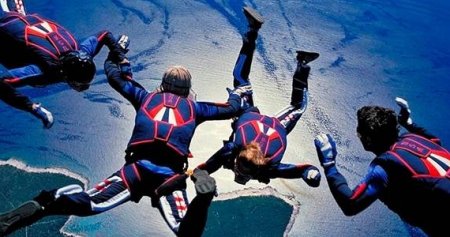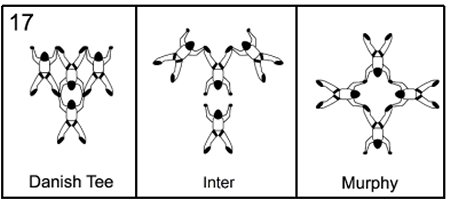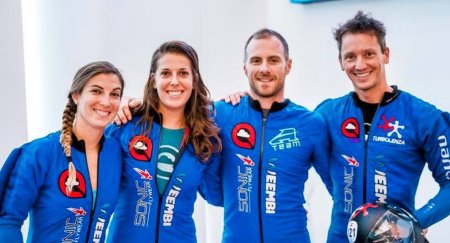
National
Skydiving
League
226 Pecan Street
Deland FL 32724
tel: (386) 801-0804
© 2003 - 2025
All Rights Reserved


226 Pecan Street
Deland FL 32724
tel: (386) 801-0804
© 2003 - 2025
All Rights Reserved


Continuity plans define on the technical side how teams are engineering the sequences that any competition draw generates, according to the rules and regulations for the FAI/IPC dive pool with the 22 blocks and 16 random formations.
Teams did not have a well defined continuity plan for the same purpose in the early years of 4-way and 8-way competition, with the current sets of rules and regulations, which were applied for the first time at the FAI World Meet 1985. Most of the engineering was based on intuitive dirt-diving with trial and error.
Year by year, and step by step, teams began to develop their own strategies and rules how to engineer the competition sequences.
Goal was to become more efficient with the training jumps and be better prepared for any competition draw. Final result of a long and ever-changing development of the continuity plans is the way teams define how to engineer any drawn competition sequences.


The development of continuity plans began with free and intuitive dirt-diving. The definition of center slots (inside - outside) and outside slots (point - tail) were added quickly, and the teams also started to define the rotation patterns of the subgroups (pieces), mostly depending on the plane's exit door (left - right).
Mirror-imaging subsequent pages due to certain blocks (Block 5 and Block 17 in the current dive pool) was applied for several years before the memorization of two different pages became the current standard for AAA Class sequences with slot-switchers (Blocks 3, 5, 10, 12, 16, 17).
The advantage of muscle memory, especially for the rotation patterns of the pieces, outscored the mirror-imaging strategy.
FAI Indoor World Cup 2018 | 1 | 2 | 3 | 4 | 5 | 6 | 7 | 8 | 9 | 10 | Total | Avg | ||||||||||||
|---|---|---|---|---|---|---|---|---|---|---|---|---|---|---|---|---|---|---|---|---|---|---|---|---|
| Rank | 4-way Open | K,17,J,21 | 4,H,F,11 | 18,L,16 | 5,M,O,C | N,8,P,19 | 6,9,10 | D,12,15 | Q,B,G,22 | 20,E,14 | 7,3,2 | Total | Avg | |||||||||||
| 1 | Weembi Mix MF | FR | 34 | -3 | 35 | 31 | 57 | 33 | -2 | 31 | 30 | 39 | 29 | -2 | 26 | -2 | 345 | 34.5 | ||||||
| 2 | NMP-PCH Hayabusa | BE | 35 | 35 | 27 | -1 | 47 | -3 | 33 | -1 | 31 | 31 | 38 | -1 | 28 | -2 | 28 | -1 | 333 | 33.3 | ||||

Team members are assigned to an "A-slot", which is defined by the exit from the jump plane or the entry into the flying chamber of a wind tunnel, and the "slot-switchers" then require the affected piece to perform the "B-slot" maneuvers.
However, the best trained teams in the world have become very flexible with their own continuity plans. They have included new options for more efficient engineering, such as new slot-switching blocks (Block 4, Block 19) and variations of positions in the random formations.
In fact, there are hardly any restrictions any longer for the top teams, as the development of continuity plans almost comes to a full circle since 1985. The top teams in the world are ready to apply any engineering option that creates a faster transition from one scoring formation to the next one.
Wind Games 2019 | 1 | 2 | 3 | 4 | 5 | 6 | 7 | 8 | 9 | 10 | Total | Avg | ||
|---|---|---|---|---|---|---|---|---|---|---|---|---|---|---|
| Rank | AAA Class | F,21,6 | L,H,22,7 | C,8,19 | 9,D,5 | 16,N,14 | 13,20,G | 4,N,J,M | 11,17,Q | 3,O,K,E | A,12,2 | Total | Avg | |
| 1 | NMP-PCH Hayabusa | BE | 33 | 37 | 31 | 50 | 31 | 26 | 46 | 34 | 39 | 27 | 354 | 35.4 |
| 2 | Weembi High Rollers | FR | 29 | 33 | 26 | 47 | 31 | 28 | 44 | 32 | 34 | 29 | 333 | 33.3 |

The Wind Games competition video of last year's FAI World Cup 4-way champions is showing an apparently unlimited continuity plan. Teams usually apply the B-slot option only when the six (or more) slot-switching blocks move the piece partners from the A-slots to the B-slots on every other page. Roy Janssen, the team's inside center, explained the new variation, where all team members take the B-slots and stay with it:
 "We are experimenting with swapping slots in order to have the best result. We no longer have 'our' slot, we start from a base (A slots), and evaluate each jump to see what probably gives the best score. Because there is a clear difference in height/weight between the girls and us, in some cases we have an advantage with them being in the center. Although there are not only advantages, as size doesn't make up for all the other skills. We try these things in training, but we need to test them in a real competition to know if we can really use it at the right time. Sometimes you lose, sometimes you win."
"We are experimenting with swapping slots in order to have the best result. We no longer have 'our' slot, we start from a base (A slots), and evaluate each jump to see what probably gives the best score. Because there is a clear difference in height/weight between the girls and us, in some cases we have an advantage with them being in the center. Although there are not only advantages, as size doesn't make up for all the other skills. We try these things in training, but we need to test them in a real competition to know if we can really use it at the right time. Sometimes you lose, sometimes you win."
It requires a wealth of training and competition experiences to be open to any engineering option, as Niklas Hemlin explained during the NSL Live Talk. The next meets will show if Weembi High Rollers continue with similar engineering, and if other teams will also apply the "continuity anarchy" option...